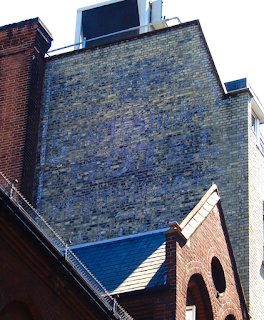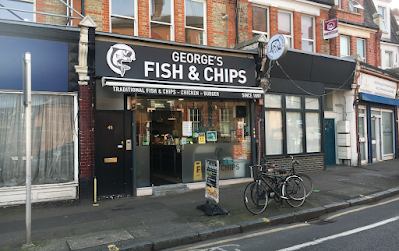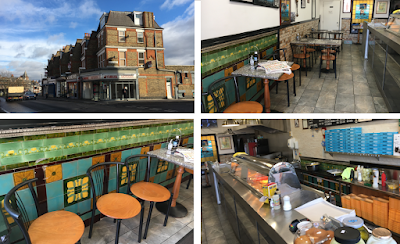I was in Shoreditch recently, wandering about admiring things, planning walking routes and generally enjoying the Winter sunshine. I decided, as I was close by, to go and visit an old friend, the hand-painted sign for Bloom’s pianos on the north side of the block that overlooks the front garden of The Museum of The Home.
Illustration of upright piano within a semi-circle
FOR PERFECTION
When I got home, I tried to find out more info about its content, but available information was scant and I ended up with more questions than answers. I had read that this sign was created for/by Philip Blumher, a Russian immigrant and master cabinet maker who "spent most of the 1930s trading here" having anglicised his name to Bloom, yet there was no evidence to back up this information. And so began days, nay weeks, of bloomin' research (see what I did there?!)...
Let's at first look at the design of this large hand-painted sign – it is clearly Edwardian/early 20th century in style as regards the letterform with those blobby serifs, undulating cross bars on the E and F, that lovely kick on the R, the curves, warps, arcs and stretches and, of course, there's that upright piano at the centre.
Also, there are direct telephone numbers on it – exchanges of this kind did not become available until 1912, though I cannot, as yet, ascertain who the Bishopsgate 9087 number belonged to, and, despite the directional at bottom right (in the form of a manicule, a cuffed hand pointing to the front of the building), I can find no ref of any Blooms listed along this terrace in the 1910s. Though they make an appearance in the 1930s. Read on...
134 Kingsland Rd is the address of the whole block from the Museum of the Home to Cremer Street and comprises seven premises A-G. If this sign is from the 1910s then it's likely that this excellent advertising space, facing the traffic coming into London from the north, was simply used to advertise products made at nearby workshops,
the sign being commissioned by an enterprising family of cabinet makers who made cases for pianofortes and had
connections to someone in this block who could accept correspondence
on their behalf. This might well have been William Richard Mitchell, shopfitter, who was at 134D&E in 1914, or Clarke & Greenfield, glass mould makers, at G. Indeed, in 1925 every one of these spaces is occupied by a company making or selling something to do with furniture.
Bloom is a fairly common (adapted) Jewish name and there have been many cabinet makers by the name of Bloom living and working in the Bethnal Green and Shoreditch area. For instance, in 1899 there was Joseph Bloom at 54 Ravenscoft Street (1), a road that was mostly cabinet makers at that time, and Nathan Bloom a short walk away at 29 Redchurch Street (2). Then, by 1910 Marks Bloom is at No.64 Ravenscroft St (1) and Joseph has moved into new premises at 5 Sunbury Works, Hocker St (3). To muddy the waters further, in 1910 there was also Leckstein & Bloom in Cheshire Street (4) with other workshops in Tabernacle Street (5) and Christina Street (6), and by 1915 Jacob Bloom is working out of Dunbridge St (7), Israel Bloom is in Leonard Street (8) and Barnett Bloom can be found at New Inn Yard (9). I have no idea if they were all related, but it's very possible.
Phew! So I’m thinking this sign could be just pre-WW1 which is backed up by the signwriter’s name, written in small ‘one stoke’ at the bottom right corner: Howell Signs, Clerkenwell – 7275.
In 1910, John Thomas Howell, illuminated signs, was located at 2 Vineyard Mews, off Farringdon Road, but he’s gone from there by 1914 and I can find no evidence thus far of him being connected with that Clerkenwell phone number at that time.
It is interesting that Howell was not local to Bethnal Green, E2, and I wonder if JTH might have been a friend or work associate of the Bloom family because I notice that Mozart & Co organ builders were at nearby 32 Vineyard Gardens from at least 1895-1910, so it's possible that the music maker connects them all, such that Mozart's mechanics might have been housed inside cabinets made by Bloom.
The Clerkenwell 7275 phone number makes an appearance in the 1923-25 directories when Lionel Victor Howell (JT's brother or son?) is listed at 10 Penton Place, Islington (Angel area today, but classed then as part of Clerkenwell) and the phone number is carried to larger premises in the 1930s, just around the corner at what is now 91-99 Pentonville Road here.
Another idea (ooh, I am full of them!) I wonder if was J.T.Howell who painted another similar-looking sign that includes an early C20th illustration, for Daniel Leakin’s valet and car hire service at 19 Wellington Row which is on the corner of Ravenscroft Street, coincidentally a couple of minutes' walk from a Bloom workshop in that street. It's very likely that, just like the Bloom's sign in Kingsland Road, this was initially an advertising site used to advertise services that were available close by. This is a small cottage-style terraced corner house so it's very doubtful a fleet of vehicles etc could be kept here. Until 1915 (just after I've lost track of any signwriters by the name of Howell) this corner location is shown as John Bates, coal dealer, who I think lived there and used it as his office. The vehicle depicted looks to be a 1920's Ford Model T light commercial in production 1908-27. As far as I am aware Leakin does not make an appearance here until the 1930s. But I've gone off on one of my tangents here, so let's park Daniel Leakin and his interwar motor haulage company for now and get back to the Blooms.
As I have hinted in the subject line, there is actually a second sign here which starts further down, sort of halfway through the big letters. If you look closely you'll notice that the lower two thirds are stronger in colour than the upper part.
I have here warped and stretched my original photo to better illustrate this. The tinted yellow box rule shows where the edges of this later sign are visible and in white I've added the letters I can ascertain thus far (though I have guessed the word 'please' at the centre).
At the bottom right there is a different telephone number from the earlier Bishopsgate one. This is confusing because, in 1939, this NORTH 1827 number belonged to George William Every & Sons, gear cutters of 49 Thornhill Road, N1, an address in Barnsbury, Islington, which is a short walk from the Blooms outlets in Caledonian Road. The Everys were in Barnsbury for at least 30 years – in 1910 they are listed as ‘clock wheel makers’ and were probably at that time supplying the Clerkenwell clock-making area. But the question here is, why on earth would Blooms be using Every's phone number? Hmm, ponder ponder... perhaps, again, this was merely for correspondence address rather than a place to buy...
I then considered the number 181 at the bottom left corner and which road in the area might this apply to – my hunch being that it must be one of the shopping streets in the N1 area. I quickly found Blooms House Furnishers (Isaac Bloom) at 181 and 187 Caledonian Road in 1939 as well as opposite at No.198, which explains that hard to decipher part in the centre of the last line = ADDRESS 181 CALEDONIAN ROAD. (Update: I have since ascertained that 'ISLINGTON' is between the road and the phone number).
Back to Kingsland Road and our Russian friend Mr Blumhert...
I have been told that in 1930, Bloom Bros cabinet makers were at 134 C, D & E, but they'd left the site by 1940. I suspect
this might coincide with the opening of the outlets in Caledonian Road, the Kings Cross area probably being better for transport and distribution, and also closer to the many piano and organ makers in north London, specifically in Islington and Camden, north of the canal.
There are no Blooms listed in the 1939 directory at the Kingsland Rd address. However, Nathan Bloom was, at this time, still busy at his workshop at 29 Redchurch Street (2 on the map above) and he had also taken on additional premises at 19-21. There’s also H&L Bloom at 3 Fountain Street, a premises that backs onto Sunbury Works (3) which must surely must be the same family seeing as this was where Joseph was listed two decades previously. 1939 also shows J. Bloom at 24A Calvin Street (10), within an attractive terrace of workshops which still looks good today.
As regards the design of the ads, note that the smaller/later advertisement has no illustration. OK, so there was less space, and the inclusion of an illustration was probably expensive, but perhaps pianos, even the ones in beautifully-made wooden cabinets, were not as much of a selling point by the time this was painted, especially with domestic gramophone players becoming more affordable.
But I have an idea why the newer sign is less tall... if you study that end wall today, or look again at my pics above, notice how the bricks at the Kingsland Rd side have been replaced – the uppermost front section of the wall has been rebuilt. It occurs to me that this might possibly have been damaged during WWI Zeppelin raids – the red line on this map clearly shows that two airships passed quite close to 134 Kingsland Road in May 1915. Alternatively, if it's a1930's sign that was later repainted, this could
hint at it being repainted during or shortly after damage
during WW2. The date of the second hinges on when the Blooms opened those premises in
Cally Rd. I'd love to see how the wall above the thinner sign would have appeared
at the time it was created – perhaps the visible elements of the earlier
sign at the top were overpainted in black.
I am still torn as regards the date/era of these advertisements. The available information is intriguingly inconclusive. The style is 1910s but the info within seems to be hinting at the 1930s which, to
me, is at odds with the old fashioned letterform used. Perhaps they used a logotype in this fin-de-siecle style, hence why the letterform continued through the decades...?
I think I will stop now as I’m bloomin’ exhausted.
Watch this space for more updates, as I will amend the info above as and when I find out more. If you can help, please use the comments box below or contact me @janeslondon via social media.

















